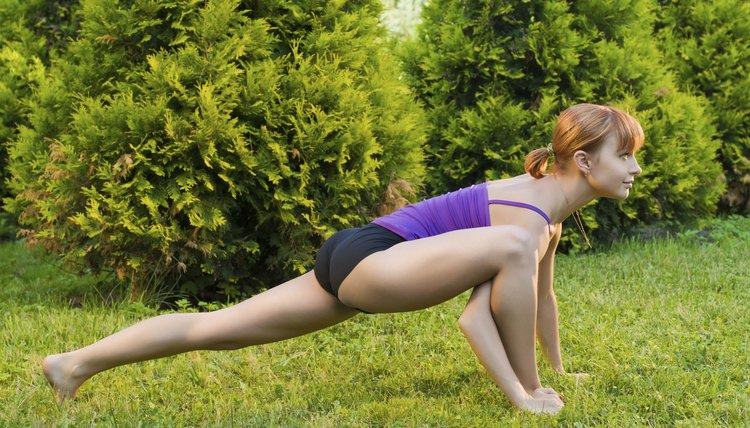Callanetics Vs. Pilates

Callanetics and Pilates can both be described as mind-body exercise forms since they focus on the link between breath and precise, aligned movement rather than on large repetitive movements. Although there are similarities between the two forms, there are also distinctions that can influence which type of training is more appropriate -- and may be more enjoyable -- for you. Check with your doctor before starting any new exercise program.
Callanetics
Invented by Callan Pinckney in the 1980s, Callanetics exercises require only an exercise mat and a sturdy chair or ballet barre. The mat exercises are similar to calisthenics, where you can expect to work in several positions, including kneeling, supine and side-lying. The standing exercises are almost isometric in nature. Expect to move in slow-motion in 1-centimeter pulses that tone and strengthen muscles without creating bulk. You can take Callanetics classes with a certified instructor, or use DVDs or books that detail the exercises and their progressions.
Pilates
Developed by Joseph Pilates during World War I, Pilates exercises can take place on an exercise mat or on one of Pilates' specialized machines, such as the reformer, Cadillac or Wunda chair. While the mat exercises are also similar to calisthenics, the spring-loaded machine movements often mimic classic yoga pose sequences. The machine can adapt to accommodate users of all strength and flexibility levels. You can take Pilates classes at a Pilates studio or fitness center, or you can learn the exercises using DVDs or books. Several manufactures have adapted the classic Pilates machines for home use as well as offering commercial versions to the general public.
Similarities
Both Callanetics and Pilates exercises rely on precise body alignment and proper body mechanics to create strong muscles that support the spine without creating bulk. Participants are encouraged to choose a range of motion that allows for stability at the center of the body. A key similarity in the mat exercises is that you do not need to purchase special equipment or even shoes. Both methods can be performed in your pajamas on a simple living room carpet.
Differences
The key difference between Callanetics and Pilates is the use of machines in some Pilates sessions. The reformer, Cadillac and Wunda chair use adaptable resistance springs to assist you in a movement, or to add resistance. Some exercises are more difficult when performed off the machines, while others are impossible without the machines. The Callanetics system does not use machines. Thousands of fitness professionals carry certifications in Pilates specialties -- such as Pilates for Golf, prenatal Pilates and Cardiolates, while there are fewer than 100 certified Callanetics teachers.
References
- Roh SY. The effects of body image, commitment, and attitude on behavior after purchase of Pilates consumers. J Exerc Rehabil. 2018;14(6):944–953. Published 2018 Dec 27. doi:10.12965/jer.1836436.218
- Lewitt MS, Mcpherson L, Stevenson M. Development of a Pilates Teaching Framework from an international survey of teacher practice. J Bodyw Mov Ther. 2019;23(4):943-949. doi:10.1016/j.jbmt.2019.02.005
- Cruz-díaz D, Bergamin M, Gobbo S, Martínez-amat A, Hita-contreras F. Comparative effects of 12 weeks of equipment based and mat Pilates in patients with Chronic Low Back Pain on pain, function and transversus abdominis activation. A randomized controlled trial. Complement Ther Med. 2017;33:72-77. doi:10.1016/j.ctim.2017.06.004
- Wells C, Kolt GS, Bialocerkowski A. Defining Pilates exercise: a systematic review. Complement Ther Med. 2012;20(4):253-262. doi:10.1016/j.ctim.2012.02.005
- Joseph Hubertus Pilates, William John Miller, Judd Robbins, Lin Van Heuit-Robbins. Pilates' Return to Life through Contrology (original publication with expanded edition). Presentation Dynamics, 2012
Writer Bio
Andrea Boldt has been in the fitness industry for more than 20 years. A personal trainer, run coach, group fitness instructor and master yoga teacher, she also holds certifications in holistic and fitness nutrition.